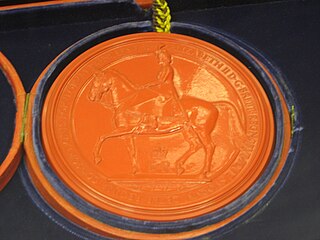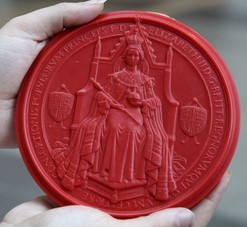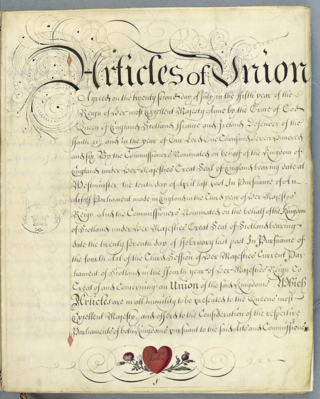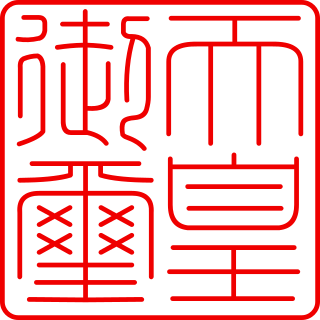
A privy seal is the personal seal of a reigning monarch, used to authenticate official documents of a personal nature, in contrast to a great seal, which is used for documents of greater importance.

A privy seal is the personal seal of a reigning monarch, used to authenticate official documents of a personal nature, in contrast to a great seal, which is used for documents of greater importance.
The Privy Seal of England can be traced back to the reign of King John. It has been suggested that it was originally the seal that accompanied the person of the Sovereign, while the Great Seal was required to remain in the Chancery. Eventually, the Privy Seal took on a broader function and was replaced by the Signet as the king's personal seal. The Great Seal Act 1884 effectively ended the use of the Privy Seal in England by providing that it was no longer necessary for any instrument to be passed under the Privy Seal.
There is also a separate Privy Seal of Scotland, which existed from at least the reign of Alexander III.
Article XXIV of the Treaty of Union provided that
the Privy Seal ... now used in Scotland be continued But that the said Seals be altered and adapted to the State of the Union as Her Majesty shall think fit And the said Seals and all of them and the Keepers of them shall be subject to such regulations as the Parliament of Great Britain shall hereafter make...
The Seal was last used in 1898 to execute the commission appointing the Rev. James Cooper to a Regius Chair at the University of Glasgow, but has never been abolished. The office of Keeper of the Privy Seal has not been filled since the death of the Marquess of Breadalbane in 1922.
The "signet or privy seal" of the Kingdom of Ireland was a single seal, whereas in England and Scotland the signet was a separate seal kept by the Clerk of the Signet and Keeper of the Signet respectively. Fiants were issued under the privy seal or signet seal by the Keeper of the Signet or Privy Seal to authorise the issue of letters patent by the Lord Chancellor of Ireland under the Great Seal of Ireland. [1]
| Dates | Holder | Notes |
|---|---|---|
| 1560–1795 | Secretary of State for Ireland | Held by as a separate office from the Secretaryship under the same letters patent. |
| 22 June 1795 – 1797 | Edmund Pery, Lord Glentworth | While Thomas Pelham was Secretary of State |
| 24 July 1797–1801 | Robert Stewart, Lord Castlereagh | Appointed Chief Secretary for Ireland in November 1798. |
| 12 June 1801–8 May 1829 | Charles Abbot, latterly 1st Baron Colchester | Appointed Chief Secretary in February 1801 and Secretary of State on 12 June 1801. Vacated both when appointed Speaker of the UK Commons in 1802 but remained Keeper until his death. |
| 8 May 1829–19 October 1922 | Chief Secretary for Ireland | The Chief Secretary was ex officio the Keeper under the Public Offices (Ireland) Act 1817 (57 Geo. 3. c. 62). [2] |

The Privy Seal of Japan is the official seal of the Emperor of Japan. While it is printed on many state documents, it is separate from the State Seal of Japan. The Privy Seal was made from copper beginning in the Nara period. After the Meiji Restoration, a new seal was made from stone in 1868. The present seal was made from gold in 1874.
The Seal has been kept by the Chamberlain of Japan since 1945, when the office of Lord Keeper of the Privy Seal was abolished. The Lord Keeper was a personal adviser to the Emperor, a position adapted in 1885 from the earlier post of Naidaijin .

His Majesty's Most Honourable Privy Council is a formal body of advisers to the sovereign of the United Kingdom. Its members, known as privy counsellors, are mainly senior politicians who are current or former members of either the House of Commons or the House of Lords.

The Lord Privy Seal is the fifth of the Great Officers of State in the United Kingdom, ranking beneath the Lord President of the Council and above the Lord Great Chamberlain. Originally, its holder was responsible for the monarch's personal (privy) seal until the use of such a seal became obsolete. Though one of the oldest offices in European governments, it has no particular function today because the use of a privy seal has been obsolete for centuries; it may be regarded as a traditional sinecure, but today, the holder of the office is invariably given a seat in the Cabinet of the United Kingdom, and is sometimes referred to as a minister without portfolio.

The Lord Chancellor, formally titled Lord High Chancellor of Great Britain, is the highest-ranking traditional minister among the Great Officers of State in Scotland and England in the United Kingdom, nominally outranking the prime minister. The lord chancellor is appointed by the sovereign on the advice of the prime minister. Prior to the union of England and Scotland into the Kingdom of Great Britain, there were separate lord chancellors for the Kingdom of England and the Kingdom of Scotland. There were Lord Chancellors of Ireland until 1922.

The Lord Keeper of the Great Seal of England, and later of Great Britain, was formerly an officer of the English Crown charged with physical custody of the Great Seal of England. This position evolved into that of one of the Great Officers of State.
Government in medieval monarchies generally comprised the king's companions, later becoming the royal household, from which the officers of state arose, initially having household and government duties. Later some of these officers became two: one serving state and one serving household. They were superseded by new officers, or were absorbed by existing officers. Many of the officers became hereditary and thus removed from practical operation of either the state or the household.

A great seal is a seal used by a head of state, or someone authorised to do so on their behalf, to confirm formal documents, such as laws, treaties, appointments and letters of dispatch. It was and is used as a guarantee of the authenticity of the most important and solemn records and documents.

The Great Seal of the Realm is a seal that is used to symbolise the sovereign's approval of state documents. It is also known as the Great Seal of the United Kingdom. To make it, sealing wax is melted in a metal mould or matrix and impressed into a wax figure that is attached by cord or ribbon to documents that the monarch wishes to seal officially. The formal keeper of the seal is the Lord High Chancellor of Great Britain.

The office of Lord Clerk Register is the oldest remaining Great Officer of State in Scotland, with origins in the 13th century. It historically had important functions in relation to the maintenance and care of the public records of Scotland. Today these duties are administered by the Keeper of the National Records of Scotland and the Keeper of the Registers of Scotland.

The Great Seal of Scotland is a principal national symbol of Scotland that allows the monarch to authorise official documents without having to sign each document individually. Wax is melted in a metal mould or matrix and impressed into a wax figure that is attached by cord or ribbon to documents that the monarch wishes to make official. The earliest seal impression, in the Treasury of Durham Cathedral, is believed to be the Great Seal of Duncan II and dates to 1094.

The Treaty of Union is the name usually now given to the treaty which led to the creation of the new state of Great Britain, providing that the Kingdom of England and the Kingdom of Scotland were to be "United into One Kingdom by the Name of Great Britain". At the time it was more often referred to as the Articles of Union.
The Lord Keeper of the Privy Seal of Japan was an administrative post not of Cabinet rank in the government of the Empire of Japan, responsible for being a direct, personal advisor to the emperor, and keeping the Privy Seal of Japan and State Seal of Japan among other things.

The Privy Seal of Japan is one of the national seals and is the Emperor of Japan's official seal.

The Great Seal of Japan is one of the national seals of Japan and is used as the official seal of state.

The King's Wardrobe, together with the Chamber, made up the personal part of medieval English government known as the King's household. Originally the room where the king's clothes, armour, and treasure were stored, the term was expanded to describe both its contents and the department of clerks who ran it. Early in the reign of Henry III the Wardrobe emerged out of the fragmentation of the Curia Regis to become the chief administrative and accounting department of the Household. The Wardrobe received regular block grants from the Exchequer for much of its history; in addition, however, the wardrobe treasure of gold and jewels enabled the king to make secret and rapid payments to fund his diplomatic and military operations, and for a time, in the 13th-14th centuries, it eclipsed the Exchequer as the chief spending department of central government.
Robert Braybrooke (1336/7-1404) was a medieval cleric and King's Secretary. He was Dean of Salisbury and Bishop of London.

The Principal Secretary of State, or Principal Secretary of the Council, was a government office in the Kingdom of Ireland. It was abolished in 1801 when Ireland became part of the United Kingdom of Great Britain and Ireland under the Acts of Union 1800.

The Privy Seal of England originally served to authenticate the king's personal communication and can be traced back to the reign of King John in the early thirteenth century. While the Great Seal was required to remain in Chancery, the Privy Seal travelled with the sovereign. However, during the second half of King Edward III's reign, in the mid-fourteenth century, the Office of the Privy Seal took on various additional government roles. This led to the development of a third seal, known at first as the "secret" seal, to handle the private communication that had been the original remit of the Privy Seal.
The Great Seal of Ireland was the seal used until 1922 by the Dublin Castle administration to authenticate important state documents in Ireland, in the same manner as the Great Seal of the Realm in England. The Great Seal of Ireland was used from at least the 1220s in the Lordship of Ireland and the ensuing Kingdom of Ireland, and remained in use when the island became part of the United Kingdom of Great Britain and Ireland (1801–1922), just as the Great Seal of Scotland remained in use after the Act of Union 1707. After 1922, the single Great Seal of Ireland was superseded by the separate Great Seal of the Irish Free State and Great Seal of Northern Ireland for the respective jurisdictions created by the partition of Ireland.

In the United Kingdom, the Great Officers of State are traditional ministers of the Crown who either inherit their positions or are appointed to exercise certain largely ceremonial functions or to operate as members of the government. Separate Great Officers exist for England and Wales, Scotland, and formerly for Ireland, though some exist for Great Britain and the United Kingdom as a whole.